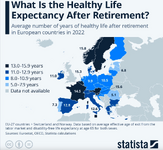It's amazing how few years those people live, even in Europe, after "retirement". Maybe that definition is really hard to pin down, though.
For most of history it was even worse in most countries. The aged pension in most countries was set at an age that was around the life expectancy or even higher. Yes the life expectancy was skewed by deaths at birth and young children dying, etc but even after accounting for that 100 years ago the average person likely would have only received the aged pension for 5 - 10 years at most before dying.
For example in Australia:
"Under the 1908 Act, age pensions were payable to both men and women at
age 65. In 1910, the pension age for women was reduced to 60 on the grounds
that women generally became ‘incapacitated for regular work at an earlier age
than men’ (Kewley, 1973, p 75), their longer life expectancy not withstanding.
These age thresholds remained unchanged until 1993, when provision was
made to increase the pension age for women to age 65 over a twenty-year
period to bring it into line with the threshold for men."
Life expectancy in Australia was just below 35 in the year 1870, and over the course of the next 150 years, it is expected to have increased to 83.2 by the year 2020.

www.statista.com
in Australia in 1910 the average life expectancy in Australia was around 54. Even if you add 10 - 15 years to 54 to counter for the skew from child deaths, men dying in wars, etc that would be aged 64 - 69. Meaning women would have received the aged pension for 4 - 9 years (eligibility at 60) and men would not have lived long enough to receive it or would have received it for maybe 4 or 5 years on average.




